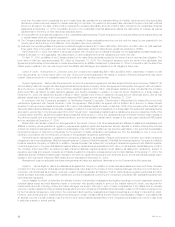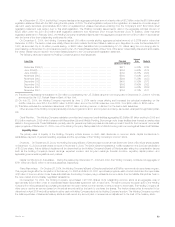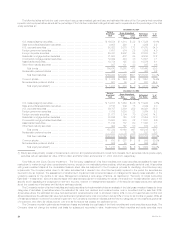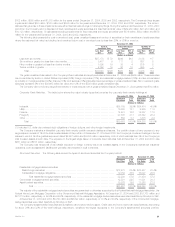MetLife 2004 Annual Report Download - page 25
Download and view the complete annual report
Please find page 25 of the 2004 MetLife annual report below. You can navigate through the pages in the report by either clicking on the pages listed below, or by using the keyword search tool below to find specific information within the annual report.
The following table contains the RBC ratios as of December 31, 2004 and 2003 and the regulatory requirements for MetLife Inc., as a bank holding
company, and MetLife Bank:
MetLife, Inc.
RBC Ratios — Bank Holding Company
As of December 31,
Regulatory Regulatory
Requirements Requirements
2004 2003 Minimum ‘‘Well Capitalized’’
Total RBC Ratio ************************************************ 10.20% 11.19% 8.00% 10.00%
Tier 1 RBC Ratio *********************************************** 9.73% 9.19% 4.00% 6.00%
Tier 1 Leverage Ratio ******************************************* 6.06% 6.12% 3.00% 5.00%
MetLife Bank
RBC Ratios — Bank
As of December 31,
Regulatory Regulatory
Requirements Requirements
2004 2003 Minimum ‘‘Well Capitalized’’
Total RBC Ratio ************************************************* 17.09% 13.12% 8.00% 10.00%
Tier 1 RBC Ratio ************************************************ 16.38% 12.50% 4.00% 6.00%
Tier 1 Leverage Ratio ******************************************** 10.84% 8.81% 3.00% 5.00%
Liquidity
Liquidity is managed to preserve stable, reliable and cost-effective sources of cash to meet all current and future financial obligations and is provided
by a variety of sources, including a portfolio of liquid assets, a diversified mix of short- and long-term funding sources from the wholesale financial markets
and the ability to borrow through committed credit facilities. The Holding Company is an active participant in the global financial markets through which it
obtains a significant amount of funding. These markets, which serve as cost-effective sources of funds, are critical components of the Holding
Company’s liquidity management. Decisions to access these markets are based upon relative costs, prospective views of balance sheet growth and a
targeted liquidity profile. A disruption in the financial markets could limit the Holding Company’s access to liquidity.
The Holding Company’s ability to maintain regular access to competitively priced wholesale funds is fostered by its current credit ratings from the
major credit rating agencies. Management views its capital ratios, credit quality, stable and diverse earnings streams, diversity of liquidity sources and its
liquidity monitoring procedures as critical to retaining high credit ratings.
Liquidity is monitored through the use of internal liquidity risk metrics, including the composition and level of the liquid asset portfolio, timing
differences in short-term cash flow obligations, access to the financial markets for capital and debt transactions and exposure to contingent draws on the
Holding Company’s liquidity.
Liquidity Sources
Dividends. The primary source of the Holding Company’s liquidity is dividends it receives from Metropolitan Life. Under New York State Insurance
Law, Metropolitan Life is permitted, without prior insurance regulatory clearance, to pay a dividend to the Holding Company as long as the aggregate
amount of all such dividends in any calendar year does not exceed the lesser of (i) 10% of its surplus to policyholders as of the immediately preceding
calendar year; and (ii) its statutory net gain from operations for the immediately preceding calendar year (excluding realized capital gains). Metropolitan Life
will be permitted to pay a dividend to the Holding Company in excess of the lesser of such two amounts only if it files notice of its intention to declare
such a dividend and the amount thereof with the Superintendent and the Superintendent does not disapprove the distribution. Under New York State
Insurance Law, the Superintendent has broad discretion in determining whether the financial condition of a stock life insurance company would support
the payment of such dividends to its stockholders. The New York State Department of Insurance has established informal guidelines for such
determinations. The guidelines, among other things, focus on the insurer’s overall financial condition and profitability under statutory accounting practices.
Management of the Holding Company cannot provide assurance that Metropolitan Life will have statutory earnings to support payment of dividends to the
Holding Company in an amount sufficient to fund its cash requirements and pay cash dividends or that the Superintendent will not disapprove any
dividends that Metropolitan Life must submit for the Superintendent’s consideration.
In addition, the Holding Company receives dividends from its other subsidiaries. The Holding Company’s other insurance subsidiaries are also
subject to similar restrictions on the payment of dividends to their respective parent companies. The dividend limitation is based on statutory financial
results. Statutory accounting practices, as prescribed by insurance regulators of various states in which the Company conducts business, differ in certain
respects from accounting principles used in financial statements prepared in conformity with GAAP. The significant differences relate to the treatment of
DAC, certain deferred income taxes, required investment reserves, reserve calculation assumptions, goodwill and surplus notes.
As of December 31, 2004, the maximum amount of the dividend which may be paid to the Holding Company by Metropolitan Life, Metropolitan
Property and Casualty Insurance Company and Metropolitan Tower Life Insurance Company in 2005, without prior regulatory approval, is $880 million,
$187 million and $119 million, respectively.
Liquid Assets. An integral part of the Holding Company’s liquidity management is the amount of liquid assets that it holds. Liquid assets include
cash, cash equivalents, short-term investments, marketable fixed maturity and equity securities. Liquid assets exclude assets relating to securities lending
and dollar roll activities. At December 31, 2004 and 2003, the Holding Company had $2,090 million and $1,302 million in liquid assets, respectively.
Global Funding Sources. Liquidity is also provided by a variety of both short and long-term instruments, including repurchase agreements,
commercial paper, medium and long-term debt, capital securities and stockholders’ equity. The diversification of the Holding Company’s funding sources
enhances funding flexibility and limits dependence on any one source of funds, and generally lowers the cost of funds.
At December 31, 2004, the Holding Company had no short-term debt outstanding as compared to $106 million at December 31, 2003. At
December 31, 2004 and 2003, the Holding Company had $5.7 billion and $4.0 billion in long-term debt outstanding, respectively.
MetLife, Inc.
22
























